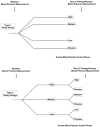Effect of renal function on antihypertensive drug safety and efficacy in children
- PMID: 28779238
- PMCID: PMC5700840
- DOI: 10.1007/s00467-017-3763-8
Effect of renal function on antihypertensive drug safety and efficacy in children
Abstract
Background: Hypertension and chronic kidney disease (CKD) are common comorbidities. Guidelines recommend treating hypertension in children with CKD because it is a modifiable risk factor for subsequent cardiovascular disease. Children with CKD are frequently excluded from antihypertensive drug trials. Consequently, safety and efficacy data for antihypertensive drugs are lacking in children with CKD.
Methods: We determined the incidence of adverse events in 10 pediatric antihypertensive trials to determine the effect of renal function on antihypertensive safety and efficacy in children. These trials were submitted to the US Food and Drug Administration from 1998 to 2005. We determined the number and type of adverse events reported during the trials and compared these numbers in participants with normal renal function and those with decreased function (defined as an estimated glomerular filtration rate [eGFR] <90 mL/min/1.73 m2 calculated using the original Schwartz equation).
Results: Among the 1,703 children in the 10 studies, 315 had decreased renal function. We observed no difference between the two cohorts in the incidence of adverse events or adverse drug reactions related to study drug. Only 5 participants, all with decreased renal function, experienced a serious adverse event; none was recorded by investigators to be study drug-related. Among treated participants, children with decreased renal function who received a high dose of study drug had a significantly larger drop in diastolic blood pressure compared with children with normal renal function.
Conclusions: These data show that antihypertensive treatment in children with renal dysfunction can be safe and efficacious, and consideration should be given to their inclusion in selected drug development programs.
Keywords: Antihypertensive drugs; Chronic kidney disease; Hypertension; Pediatrics.
Conflict of interest statement
The work of KMW was supported under an Intergovernmental Personnel Agreement (IPA) between the U.S. Food and Drug Administration and Duke University.
K.M.W. receives support from the National Institute of Child Health and Human Development (NICHD) (1K23HD075891, 5K12HD047349) and the Thrasher Research Fund for his work in pediatric clinical pharmacology. D.K.B. Jr. receives support from the National Institutes of Health (NIH) (award 2K24HD058735-06, National Center for Advancing Translational Sciences (NCATS)award UL1TR001117, NICHD contract HSN275201000003I, and National Institute of Allergy and Infectious Diseases [NIAID] contract HHSN272201500006I); he also receives research support from Cempra Pharmaceuticals (subaward to HHSO100201300009C) and industry for neonatal and pediatric drug development (
P.B.S. receives salary support for research from the NIH and the NCATS of the NIH (UL1TR001117), the NICHD (HHSN275201000003I and 1R01-HD081044-01), and the Food and Drug Administration (FDA) (1R18-FD005292-01); he also receives research support from Cempra Pharmaceuticals (subaward to HHS0100201300009C) and industry for neonatal and pediatric drug development (
Similar articles
-
Estimated glomerular filtration rate reversal by blood pressure lowering in chronic kidney disease: Japan Multicenter Investigation for Cardiovascular DiseaseB CKD study.J Clin Hypertens (Greenwich). 2013 Mar;15(3):171-5. doi: 10.1111/jch.12054. Epub 2012 Dec 14. J Clin Hypertens (Greenwich). 2013. PMID: 23458588 Free PMC article. Clinical Trial.
-
Renal denervation preserves renal function in patients with chronic kidney disease and resistant hypertension.J Hypertens. 2015 Jun;33(6):1261-6. doi: 10.1097/HJH.0000000000000556. J Hypertens. 2015. PMID: 25923731
-
Antihypertensive medication nonadherence and target organ damage in children with chronic kidney disease.Pediatr Nephrol. 2024 Jan;39(1):221-231. doi: 10.1007/s00467-023-06059-w. Epub 2023 Jul 13. Pediatr Nephrol. 2024. PMID: 37442816 Free PMC article.
-
Withdrawal of antihypertensive drugs in older people.Cochrane Database Syst Rev. 2020 Jun 10;6(6):CD012572. doi: 10.1002/14651858.CD012572.pub2. Cochrane Database Syst Rev. 2020. Update in: Cochrane Database Syst Rev. 2025 Mar 31;3:CD012572. doi: 10.1002/14651858.CD012572.pub3. PMID: 32519776 Free PMC article. Updated.
-
Amlodipine Compared with Benidipine in the Management of Hypertension: A Systematic Review and Meta-Analysis.High Blood Press Cardiovasc Prev. 2020 Dec;27(6):527-537. doi: 10.1007/s40292-020-00412-y. Epub 2020 Oct 1. High Blood Press Cardiovasc Prev. 2020. PMID: 33001356
Cited by
-
Dosing Recommendations for Pediatric Patients With Renal Impairment.J Clin Pharmacol. 2020 Dec;60(12):1551-1560. doi: 10.1002/jcph.1676. Epub 2020 Jun 15. J Clin Pharmacol. 2020. PMID: 32542790 Free PMC article.
-
Management of Hypertension in CAKUT: Protective Factor for CKD.Front Pediatr. 2019 Jun 4;7:222. doi: 10.3389/fped.2019.00222. eCollection 2019. Front Pediatr. 2019. PMID: 31214554 Free PMC article. Review.
References
-
- Mitsnefes M, Ho PL, McEnery PT. Hypertension and progression of chronic renal insufficiency in children: a report of the North American Pediatric Renal Transplant Cooperative Study (NAPRTCS) J Am Soc Nephro. 2003;14(10):2618–2622. - PubMed
-
- Wuhl E, Trivelli A, Picca S, Litwin M, Peco-Antic A, Zurowska A, Testa S, Jankauskiene A, Emre S, Caldas-Afonso A, Anarat A, Niaudet P, Mir S, Bakkaloglu A, Enke B, Montini G, Wingen AM, Sallay P, Jeck N, Berg U, Caliskan S, Wygoda S, Hohbach-Hohenfellner K, Dusek J, Urasinski T, Arbeiter K, Neuhaus T, Gellermann J, Drozdz D, Fischbach M, Möller K, Wigger M, Peruzzi L, Mehls O, Schaefer F ESCAPE Trial Group. Strict blood-pressure control and progression of renal failure in children. N Engl J Med. 2009;361(17):1639–1650. - PubMed
-
- Kidney Disease Outcomes Quality Initiative (K/DOQI) Clinical practice guidelines on hypertension and antihypertensive agents in chronic kidney disease. Am J Kidney Dis. 2004;43(Suppl):S1–S290. - PubMed
-
- National High Blood Pressure Education Program Working Group on High Blood Pressure in Children and Adolescents. The fourth report on the diagnosis, evaluation, and treatment of high blood pressure in children and adolescents. Pediatrics. 2004;114(2 Suppl):555–576. 4th Report. - PubMed
MeSH terms
Substances
Grants and funding
- K24 HD058735/HD/NICHD NIH HHS/United States
- P30 DK096493/DK/NIDDK NIH HHS/United States
- R01 HD081044/HD/NICHD NIH HHS/United States
- HHSN275201000003C/HD/NICHD NIH HHS/United States
- FD999999/ImFDA/Intramural FDA HHS/United States
- HHSN275201000003I/HD/NICHD NIH HHS/United States
- R18 FD005292/FD/FDA HHS/United States
- K12 HD047349/HD/NICHD NIH HHS/United States
- K23 HD090239/HD/NICHD NIH HHS/United States
- UL1 TR001117/TR/NCATS NIH HHS/United States
- K23 HD075891/HD/NICHD NIH HHS/United States
- HHSN272201500006C/AI/NIAID NIH HHS/United States
LinkOut - more resources
Full Text Sources
Other Literature Sources
Medical
Research Materials
Miscellaneous


